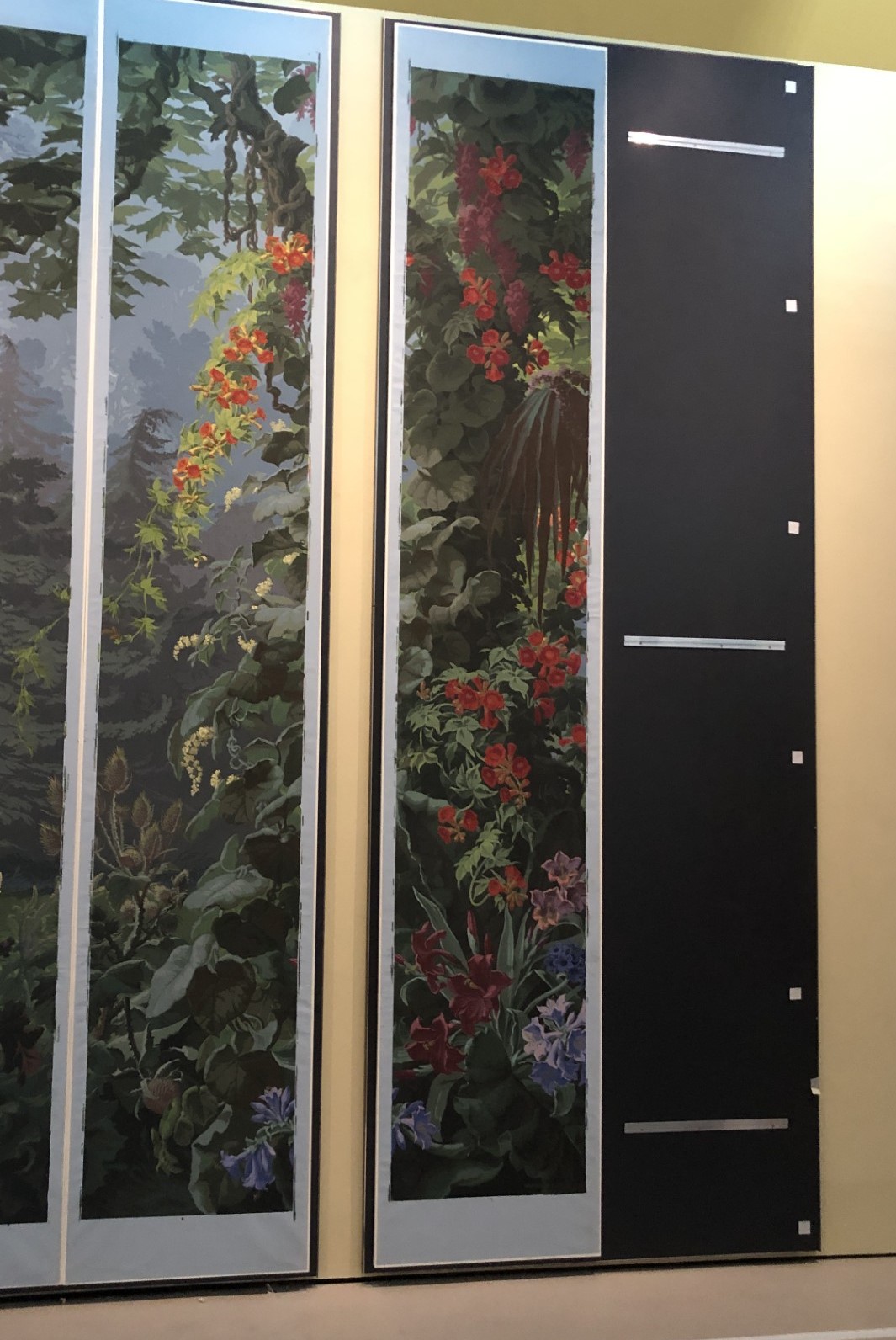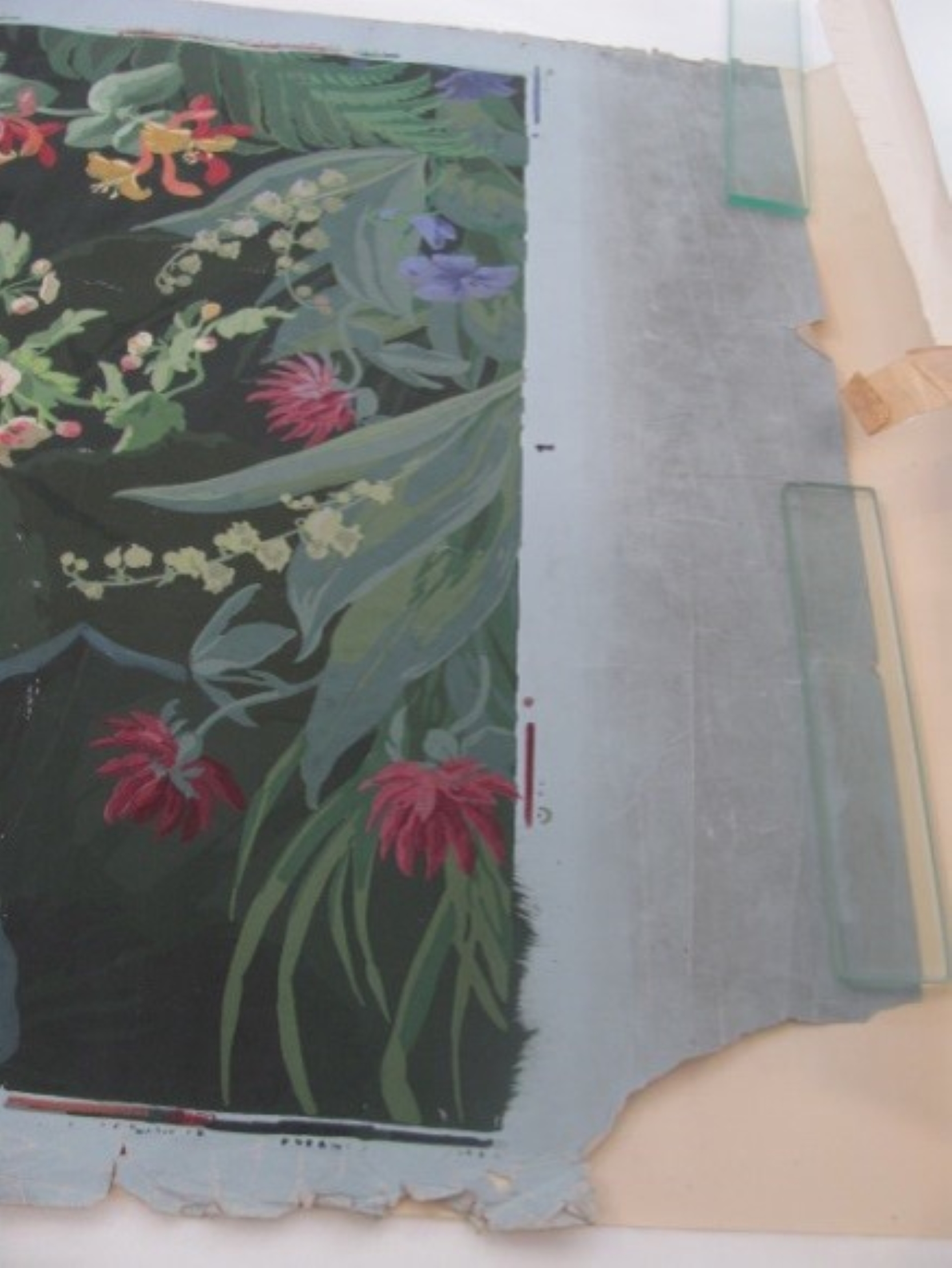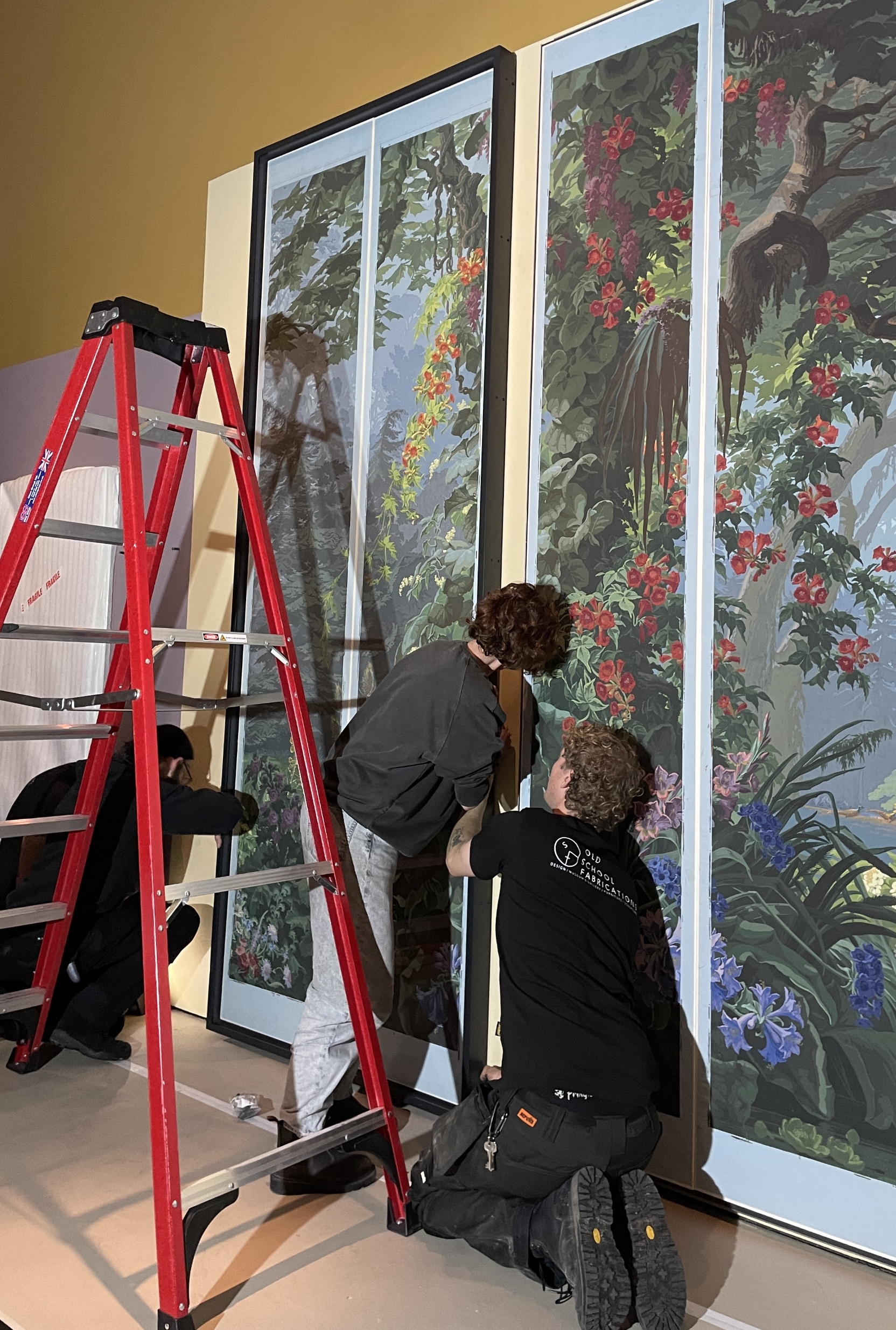L’Eden is a magnificent panoramic wallpaper series manufactured in France in 1861 (first edition) by Jules Desfossé from a design by Joseph Fuchs. The National Museums Scotland (NMS) have in their collection twenty rolls of L’Eden of which four are on display within their Design for Living gallery at the National Museum of Scotland, Edinburgh. The Design for Living gallery explores the influence of design movements on people’s homes. Wallpaper was a way of transforming an interior into a new in this case imaginary landscape highlighting the belief that people’s surroundings had a direct relationship to their physical and spiritual well-being. L’Eden is an impressive object at 3 metres in height and transports the viewer into an idyllic vibrant world of flowers, foliage, birds and animals showcasing plants found in European botanical gardens of the time.
Claire Blakey (Curator of Modern Decorative Arts) describes the gallery as exploring ‘the 100 years of design history between the great exhibition of 1851 and the festival of Britain in 1951. This period saw a transformation in design in Europe and North America and a focus on what was considered good design whether for mass produced items or artistic works’.

Background on the Wallpaper
The wallpaper was hand printed using over 3,600 printing blocks and distemper (a pigment usually in a proteinaceous medium) – a technically challenging process. As such L’Eden was a luxury item and would have been affordable only to the wealthy. What makes this panorama even more unique is that, despite its expense, it was never hung or even trimmed as each piece still retains the original borders. This survivor is considered a uniquely well-preserved example and only one other example is known to exist.

The wallpaper came to the collection in the 1960s but was not displayed or conserved until recently when in 2016 the National Museums Scotland opened a newly redeveloped suite of galleries successfully displaying even more examples from the 12 million strong collection. Displaying a sensitive object however has its caveats.
Framing and Display
Museums have a duty of care to their collection and aim to preserve their collections for future generations. To achieve this is it necessary to ‘rotate’ the displays of environmentally sensitive objects. Once sensitivity is determined, appropriate rotation substitutes which do not compromise the integrity and vibrancy of the gallery are identified. With twenty rolls available L’Eden proved to be a perfect choice for display and rotation. The decision was to exhibit four rolls at a time, for a four year period at a maximum light exposure of 50 lux. This would therefore give twenty years of display.
The first four rolls were initially mounted onto rigid panels unframed and hung on ‘open display’. This however exposed the wallpaper to dust, airborne pollutants and physical damage. At over 300cm x 50cm the dimensionally unstable wallpapers were susceptible to distortion and cockling due to fluctuations in relative humidity (RH).
A risk assessment was carried out to consider the impact of physical damage, threat from water ingress, dust and pollutants and environmental (RH and light) damage. Various barriers, plinths, acrylic stand offs and overhead covers were considered but the only option that really mitigated these risks was to frame the wallpaper.
The frame would need to be sealed but accessible to allow for the four yearly rotations and made of tested and off-gassed materials sturdy enough to take such large glazing panels but look in keeping with the aesthetic of the Design for Living gallery.
Due to the size it was decided to use two frames – each housing two wallpaper sections. This would not only reduce weight but also ease installation. The challenge was to find large enough and suitable glazing.
The most appropriate glazing was 6mm Tru Vue® Optium Museum Acrylic® offering low reflect, anti-scratch with UV filtering properties. Tru Vue very generously donated the Optium® and procurement and delivery was organised through Wessex Pictures (UK). The wallpaper, at a height of over 3 metres, was taller than a standard sheet of Optium, so it was necessary to join two pieces to form each glazing panel of 3,258 x 1,284mm. Seaming the Optium® was undertaken by SmallCorp in the USA. The resulting seam created a barely visible but strong horizontal join at the upper quadrant of each panel.
A frame was manufactured in Edinburgh by Old School fabrications. The frames are made of two sections – front and back. The back piece comprises sealed and painted ZF MDF with a welded and powder coated aluminium L section frame. The front section is also constructed from a welded powder-coated aluminium L section. Oddy tested rubber seals were fitted to the front section to ensure a tight fit. The low profile back section was fixed to the gallery wall and the wallpapers were then mounted onto the back section using low profile aluminium split battens. The front glazed section was then fitted to the back section using screws around the edges.
These two frames were in keeping with the overall design of the gallery having a sleek profile with powder coated finish. The front sections lift off by unscrewing which will allow for relatively easy rotation every four years. Future wallpaper panels will also hang on the split batten mechanism.

Conservation Treatment
To prepare the wallpapers for display it was necessary to undertake a lengthy conservation treatment. On entering the collection over 50 years ago the wallpapers were tightly rolled and damaged along all edges. Inevitably dirt and damp had affected their condition but they were still remarkably vibrant and relatively intact.


Each wallpaper was surface cleaned using soft latex erasers and brushes. Repairs of the multiple edge tears were completed using Japanese tissue and wheat starch paste.
Horizontal creases and cracks with media loss were evident due to the rolling and friable areas were consolidated using Ethyl hydroxyethyl cellulose (EHEC). To enable mounting a strip of machine-made Japanese paper (paper mulberry fibre) was attached along all edges using wheat starch paste with a verso overlap of a few millimetres. After humidification the wallpapers were stretched out on long wooden boards. Whilst stretched it was possible to undertake repairs, using patches toned with gouache and pastel. Reversible retouching was undertaken using pastel pencils to replicate some the powdery appearance of the distemper.

It was imperative that a very rigid board was used to prevent any bowing of the mounted wallpapers. Panels of Aluminium Honeycomb boards were chosen. These were modified by adhering 100% cotton Museum board to the front and back surfaces which were in contact with the wallpaper. This was adhered with an epoxy adhesive.

The wallpaper was then attached to the panels by wrapping the Japanese paper strips around the edge and securing with paper gum tape to the back. Three low profile aluminium split battens were attached to the back of these honeycomb panels before the objects were attached.
Front opening Tyvek covers were made to protect the objects during transit and storage.
Hanging the Wallpaper
Moving the wallpapers from our off-site conservation studios to the historic National Museum of Scotland in central Edinburgh was a complex task. Careful planning overseen by Displays Officer Jack Saunders was necessary to ensure a safe delivery and install of these large and fragile objects. This successful collaboration between cross departmental teams resulted in the four wallpapers being safely installed in April 2024.

L’Eden is a focal point of the Design for Living Gallery and can now be viewed in context with other objects of the period. The new frame has not detracted but accentuate these impressive and attractive wallpapers. The frame acts like a window onto this idyllic vista and draw the visitors in to explore the space. Now they are framed they are safeguarded from physical and environmental damage and will be enjoyed by visitors for many years to come.

THANKS:
- National Museums Scotland are extremely grateful to Tru Vue® Inc for their generous donation of Optium Museum Acrylic® glazing and to Ryan Younger at Wessex Pictures for organising the delivery and seaming with SmallCorp, MA.
- Neville Rae, Scott Laverie and Harry Campbell of Old School Fabrications who constructed and installed the frame.
- Thanks to my colleagues Jack Saunders (Displays Officer) and Claire Blakey (Curator of Modern Decorative Arts) who heartily contributed to this article. Ste Dobbins, Amelia Bywater, Steven Anderson and Duncan Marquiss for installation. And my supportive colleagues in Paper and Textiles conservation and Collections Care for their help with conservation and delivery.
Share this Article:
This article is intended for educational purposes only and does not replace independent professional judgment. Statements of fact and opinions expressed are those of the author(s) individually and, unless expressly stated to the contrary, are not the opinion or position of Tru Vue or its employees. Tru Vue does not endorse or approve, and assumes no responsibility for, the content, accuracy or completeness of the information presented.